Inkjet Printing Is a Promising Method of Dyeing Polymer Textile Materials
Abstract
1. Introduction
2. Research Methodology
3. Inkjet Basics
3.1. Piezoelectric Inkjet Printing (PIJ)
3.2. Thermal Inkjet Printing (TIJ)
4. Ink for Color Digital Inkjet Printing
| Chemical Composition | Concentration (wt%) | ||||||||
|---|---|---|---|---|---|---|---|---|---|
| [34] | [35] | [36] | [37] | [38] | [39] | [40] | [41] | [42] | |
| Disperse dye | 5.01% (magenta 896, yellow 54, blue 359) | 4–5% (Carbojet 300) | 4.5% (Yellow 54) | 3–5% (Blue 359) | 3.3% (Red 60) | 3% (Blue 359) | 3% (Blue 79, Yellow 48) | 10% (Red 60) | 6% (FW-18 Soot) |
| Deionized water | 64–82% | Balance | 68.15–86.15% | 61.90–69.90% | 48–69% | 61.48–65.39% | 72.625–73.125% | 48.440% | 80.70% |
| Ethylene glycol, EG (C2H4(OH)2) | 2.50–22.50% | -- | 4.50% | 23–25% | 20.30% | 3% | 20% | 20% | -- |
| Diethylene glycol, DEG ((HOCH2CH2)2O) | 5.01% | -- | -- | -- | -- | -- | -- | 20% | 2% |
| Sodium naphthalene sulfonate-formaldehyde, MF ((C10H7NaO3S)x(CH2O)x) | -- | -- | -- | 3–5% | 3.30% | 3% | 3% | 15% | -- |
| Organosilicon defoamer | 0.50% | -- | 0.05% | 0.05% | 0.05% | 0.065% | -- | 0.05% | -- |
| Triethanolamine, TEA ((HO-CH2CH2)3N) | 0.05% | -- | -- | 0.05% | 0.05% | 0.05% | 0.05% | 0.50% | -- |
| Polyethylene glycol, PEG (g/mol) | -- | -- | -- | 0–2% | -- | -- | PEG1000 2% | PEG400 0–0.97% | -- |
| 2-pyrrolidone (C4H7NO) | -- | 10% | -- | -- | -- | -- | -- | -- | 5% |
| Glycerol (C3H5(OH)3) | -- | -- | 0–20% | -- | 1% | -- | -- | -- | 4.50% |
| Polyvinylpyrrolidone, PVP K15, K30, K60 (C6H9NO) | -- | -- | 0–2% | -- | -- | -- | K30 0.5% | -- | |
| Acetylene glycol derivative, Surfinol 465 | -- | 0.05–0.10% | -- | -- | -- | -- | -- | -- | 0.10% |
| Stirolmaleic anhydride SMA2000 ((C8H8)n-(C4H2O3)m) | -- | 0.7–2% | -- | -- | -- | -- | -- | -- | -- |
| Sodium lauryl sulfate, SDS (CH3(CH2)11OSO3Na) | -- | -- | -- | -- | 1% | 0.50% | -- | -- | -- |
| Polyacrylate emulsion ((-CH2-CR’(COOR)-)n) | -- | -- | -- | -- | 0–21% | 0–3.906% | -- | -- | -- |
| Butane-1,2-diol (C4H8(OH)2) | -- | -- | -- | -- | -- | 25% | -- | -- | -- |
| Propanediol, PGI (C3H6(OH)2) | -- | -- | -- | -- | -- | -- | -- | 20% | -- |
| Copolymer of polyacrylic acid (Hydrophilic block), TD-1109 | 2.76% | -- | -- | -- | -- | -- | -- | -- | -- |
| Viscosity (mPa⋅s) | 1.2–3.2 | 2.3–2.8 | 1.81–5.94 | 2.36–5.11 | 2.3–11.1 | 3.8–4.3 | 2.06–2.56 | 4.8–9.4 | 2.73 |
| Surface tension (mN/m) | 31–33 | 30–35 | 30.14–31.88 | 34.97–42.01 | 33.3–34.5 | 37.8–39 | 29.78–30.36 | 42.4–47.6 | 39.7 |
| Average particlesize (nm) | 145.4–166.7 (P), 171.5–186 (W), 171.5–187.5 (C) | -- | 183–198 | 142.6–152.8 | 131.3–147.8 | 167–170.5 | 184.9–188.4 | 165.5–165.3 | 163.4 |
4.1. Characterization of Dispersed Inkjet Inks
| Viscosity, mPa⋅s | Surface Tension, mN/m | Particle Size, nm | pH | Zeta-Potential of Particles, mV | Reference | |
|---|---|---|---|---|---|---|
| Epson R330 (Seiko Epson Corporation, Japan) | 1.6–11.1 | 33.2–37.3 | 112.3–147.8 | 7.6–8 | 25–35 | [41,48] |
| Dimatix DMP-2800 | 2.8–3.2 | 30–49 | 129–160 | 7–9 | – | |
| HP Deskjet | 2.1–3.5 | 26–38 | 41–89 | 10 | 34–55 | [49] |
| RK Flexiproof 100 (TMI Machines, USA) | 1.93–5.59 | 30–32 | 145–190 | 7–8 | – | [50] |
| Epson R230 (Seiko Epson Corporation, Japan) | 2.06–3.24 | 31.09–32.95 | 147.2–166.7 | 7.6–7.8 | – | [36] |
4.2. Dispersed Inks for Dyeing Textile Materials
4.2.1. Inkjet Ink for Printing on Nylon Fiber
| Thickener | Concentration, % | Viscosity, mPa⋅s | Surface Tension, mN/m | Reference |
|---|---|---|---|---|
| Sodium alginate (SA) | 0.5–1.75 | 0.18–4 | 31–36 | [55] |
| Natrozole | 3 | 3–20 | 32–36.3 | [56] |
| Polyacrylic acid | 1 | 0.18–4.00 | 29–35 | [56] |
4.2.2. Inkjet Ink for Printing on Cotton Fiber
| Additive | Concentration, % | Viscosity, mPa⋅s | Surface Tension, mN/m | Reference |
|---|---|---|---|---|
| N-methylmorpholine N-oxide | 2 | 2–2.8 | 28–31 | [57] |
| Diethylene glycol | 0–50 | 1–6 | 57–75 | [61,62] |
| Carboxymethyl cellulose | 3 | 3.35 | 27–34 | [63] |
4.2.3. Inkjet Ink for Printing on Silk
4.2.4. Inkjet Ink for Printing on Polyester Fiber
4.2.5. Inkjet Ink for Printing on Polypropylene Fiber
5. Modification of Material Surfaces
5.1. Physical Methods of Surface Modification
5.2. Chemical Methods of Surface Modification
5.3. Physicochemical Methods of Surface Modification
6. Prospects for Inkjet Printing Applications in Textiles
7. Conclusions
Author Contributions
Funding
Data Availability Statement
Conflicts of Interest
References
- Ju, B.; Kim, I.; Li, B.M.; Knowles, C.G.; Mills, A.; Grace, L.; Jur, J.S. Inkjet Printed Textile Force Sensitive Resistors for Wearable and Healthcare Devices. Adv. Healthc. Mater. 2021, 10, 2100893. [Google Scholar] [CrossRef]
- Uzun, S.; Schelling, M.; Hantanasirisakul, K.; Mathis, T.S.; Askeland, R.; Dion, G.; Gogotsi, Y. Additive-Free Aqueous MXene Inks for Thermal Inkjet Printing on Textiles. Small 2021, 17, 2006376. [Google Scholar] [CrossRef]
- Kim, I.; Ju, B.; Zhou, Y.; Li, B.M.; Jur, J.S. Microstructures in All-Inkjet-Printed Textile Capacitors with Bilayer Interfaces of Polymer Dielectrics and Metal–Organic Decomposition Silver Electrodes. ACS Appl. Mater. Interfaces 2021, 13, 24081–24094. [Google Scholar] [CrossRef] [PubMed]
- Shah, M.A.; Lee, D.-G.; Lee, B.-Y.; Hur, S. Classifications and Applications of Inkjet Printing Technology: A Review. IEEE Access 2021, 9, 140079–140102. [Google Scholar] [CrossRef]
- Qiao, X.; Fang, K.; Liu, X.; Gong, J.; Zhang, S.; Wang, J.; Zhang, M. Different influences of hydroxypropyl methyl cellulose pretreatment on surface properties of cotton and polyamide in inkjet printing. Prog. Org. Coat. 2022, 165, 106746. [Google Scholar] [CrossRef]
- Thakker, A.M.; Sun, D.; Bucknall, D. Inkjet printing of plasma surface–modified wool and cotton fabrics with plant-based inks. Environ. Sci. Pollut. Res. 2022, 29, 68357–68375. [Google Scholar] [CrossRef] [PubMed]
- Biswas, T.; Yu, J.; Nierstrasz, V. Effective Pretreatment Routes of Polyethylene Terephthalate Fabric for Digital Inkjet Printing of Enzyme. Adv. Mater. Inter. 2021, 8, 2001882. [Google Scholar] [CrossRef]
- Kuo, C.-H.; Shiu, J.-W.; Rwei, S.-P. Preparation and characterization of PMMA encapsulated carbon black for water-based digital jet printing ink on different fibers of cotton and PET. Colloids Surf. A Physicochem. Eng. Asp. 2022, 648, 129450. [Google Scholar] [CrossRef]
- Peng, H.; Xie, R.; Fang, K.; Cao, C.; Qi, Y.; Ren, Y.; Chen, W. Effect of Diethylene Glycol on the Inkjet Printability of Reactive Dye Solution for Cotton Fabrics. Langmuir 2021, 37, 1493–1500. [Google Scholar] [CrossRef]
- Vasilev, S.; Vodyashkin, A.; Vasileva, D.; Zelenovskiy, P.; Chezganov, D.; Yuzhakov, V.; Shur, V.; O’reilly, E.; Vinogradov, A. An Investigative Study on the Effect of Pre-Coating Polymer Solutions on the Fabrication of Low Cost Anti-Adhesive Release Paper. Nanomaterials 2020, 10, 1436. [Google Scholar] [CrossRef]
- Li, Y.; Cao, C.; Feng, F.; Fang, K.; Wang, M.; Xie, R.; Zhao, Z.; Chen, W. High-performance inkjet printing ink: Properties and application effects of vinyl sulfone reactive dye-based inks. J. Mol. Liq. 2023, 369, 120864. [Google Scholar] [CrossRef]
- Kim, H.-J.; Hong, J.-P.; Kwak, D.-S.; Kwon, D.-J. Acrylic polymer treatment on Nylon fibers improves color strength and durability in thermal transfer printing. Colloids Surf. A Physicochem. Eng. Asp. 2021, 615, 126268. [Google Scholar] [CrossRef]
- Khan, S.; Ali, S.; Khan, A.; Bermak, A. Developing pressure sensors from impregnated textile sandwiched in inkjet-printed electrodes. J. Mater. Sci. Mater. Electron. 2022, 33, 541–553. [Google Scholar] [CrossRef]
- Stempien, Z.; Khalid, M.; Kozanecki, M.; Filipczak, P.; Wrzesińska, A.; Korzeniewska, E.; Sąsiadek, E. Inkjet Printing of Polypyrrole Electroconductive Layers Based on Direct Inks Freezing and Their Use in Textile Solid-State Supercapacitors. Materials 2021, 14, 3577. [Google Scholar] [CrossRef]
- Hussain, A.; Abbas, N.; Ali, A. Inkjet Printing: A Viable Technology for Biosensor Fabrication. Chemosensors 2022, 10, 103. [Google Scholar] [CrossRef]
- Subitha, D.; Rahul, S.G.; Velmurugan, S.; Saiteja, S. Curing Free, Silver Nano Ink Based Inkjet Printed Fabrics for Bio-Medical Applications. In Proceedings of the 2022 IEEE International Conference on Nanoelectronics, Nanophotonics, Nanomaterials, Nanobioscience & Nanotechnology (5NANO), Kottayam, India, 28–29 April 2022; pp. 1–4. [Google Scholar] [CrossRef]
- Pan, Z.; Wang, Y.; Huang, H.; Ling, Z.; Dai, Y.; Ke, S. Recent development on preparation of ceramic inks in ink-jet printing. Ceram. Int. 2015, 41, 12515–12528. [Google Scholar] [CrossRef]
- Deng, Y.; Li, Q.; Zhou, Y.; Qian, J. Fully Inkjet Printing Preparation of a Carbon Dots Multichannel Microfluidic Paper-Based Sensor and Its Application in Food Additive Detection. ACS Appl. Mater. Interfaces 2021, 13, 57084–57091. [Google Scholar] [CrossRef]
- Shanker, R.; Sardar, S.; Chen, S.; Gamage, S.; Rossi, S.; Jonsson, M.P. Noniridescent Biomimetic Photonic Microdomes by Inkjet Printing. Nano Lett. 2020, 20, 7243–7250. [Google Scholar] [CrossRef]
- Zhang, Q.; Jin, Q.; Mertens, A.; Rainer, C.; Huber, R.; Fessler, J.; Hernandez-Sosa, G.; Lemmer, U. Fabrication of Bragg Mirrors by Multilayer Inkjet Printing. Adv. Mater. 2022, 34, 2201348. [Google Scholar] [CrossRef]
- Levit, B.; Krebsbach, P.; Bar-Haim, C.; Hernandez-Sosa, G.; Hanein, Y. Printed soft skin electrodes for seamless bio-impedance measurements. Flex. Print. Electron. 2023, 8, 015020. [Google Scholar] [CrossRef]
- Zhang, X.; Jiang, X.; Zhang, Z.; Qin, H. Fabrication of silver microstructures via electrohydrodynamic inkjet printing as customizable X-ray marker in bio-structure for biomedical diagnostic imaging. Int. J. Adv. Manuf. Technol. 2021, 114, 241–250. [Google Scholar] [CrossRef]
- Wang, C.; Park, M.J.; Choo, Y.W.; Huang, Y.; Phuntsho, S.; Shon, H.K. Inkjet printing technique for membrane fabrication and modification: A review. Desalination 2023, 565, 116841. [Google Scholar] [CrossRef]
- Zhou, X.; Zheng, B. Surface modification for improving immunoassay sensitivity. Lab. Chip. 2023, 23, 1151–1168. [Google Scholar] [CrossRef]
- Liu, H.; Yin, Y.; Zhou, J.; Yang, H.; Guo, L.; Peng, F.; Qi, H. Fabrication of durable fluorescent and hydrophobic cotton fabrics by multiple surface modifications. Ind. Crops Prod. 2022, 175, 114238. [Google Scholar] [CrossRef]
- Chen, P.-H.; Peng, H.-Y.; Liu, H.-Y.; Chang, S.-L.; Wu, T.-I.; Cheng, C.-H. Pressure response and droplet ejection of a piezoelectric inkjet printhead. Int. J. Mech. Sci. 1999, 41, 235–248. [Google Scholar] [CrossRef]
- Jiao, T.; Lian, Q.; Zhao, T.; Wang, H. Influence of ink properties and voltage parameters on piezoelectric inkjet droplet formation. Appl. Phys. A 2021, 127, 11. [Google Scholar] [CrossRef]
- Li, K.; Liu, J.; Chen, W.; Zhang, L. Controllable printing droplets on demand by piezoelectric inkjet: Applications and methods. Microsyst. Technol. 2018, 24, 879–889. [Google Scholar] [CrossRef]
- Kim, B.-H.; Kim, S.-I.; Shin, H.-H.; Park, N.-R.; Lee, H.-S.; Kang, C.-S.; Shin, S.-J.; Kim, S.-J. A Study of the Jetting Failure for Self-Detected Piezoelectric Inkjet Printheads. IEEE Sens. J. 2011, 11, 3451–3456. [Google Scholar] [CrossRef]
- Chen, P.-H.; Chen, W.-C.; Chang, S.-H. Bubble growth and ink ejection process of a thermal ink jet printhead. Int. J. Mech. Sci. 1997, 39, 683–695. [Google Scholar] [CrossRef]
- Rembe, C.; Aus Der Wiesche, S.; Hofer, E.P. Thermal ink jet dynamics: Modeling, simulation, and testing. Microelectron. Reliab. 2000, 40, 525–532. [Google Scholar] [CrossRef]
- Okuyama, K.; Tsukahara, S.; Morita, N.; Iida, Y. Transient behavior of boiling bubbles generated on the small heater of a thermal ink jet printhead. Exp. Therm. Fluid Sci. 2004, 28, 825–834. [Google Scholar] [CrossRef]
- Le, H.P. Progress and trends in ink-jet printing technology. J. Imaging Sci. Technol. 1998, 42, 49–62. [Google Scholar] [CrossRef]
- Gao, C.; Xing, T.; Hou, X.; Chen, G. Preparation of disperse inks for direct inkjet printing of non-pretreated polyester fabrics. RSC Adv. 2019, 9, 19791–19799. [Google Scholar] [CrossRef] [PubMed]
- Magdassi, S. The chemistry of inkjet inks. In World Scientific; World Scientific Pub Co Pte Ltd.: Singapore, 2009. [Google Scholar]
- Gao, C.; Zhang, Z.; Xing, T.; Hou, X.; Chen, G. Controlling the micro-structure of disperse water-based inks for ink-jet printing. J. Mol. Liq. 2020, 297, 111783. [Google Scholar] [CrossRef]
- Gao, C.; Xing, T.; Chen, G. Research on micro mechanism of water-based disperse ink and optimization of driving waveform for inkjet ink. Colloids Surf. A Physicochem. Eng. Asp. 2020, 606, 125237. [Google Scholar] [CrossRef]
- Gao, C.; Xing, T.; Hou, X.; Zhang, Y.; Chen, G. Clean production of polyester fabric inkjet printing process without fabric pretreatment and soaping. J. Clean. Prod. 2021, 282, 124315. [Google Scholar] [CrossRef]
- Gao, C.; Wang, H.; Zhao, H.; Shi, S.; Guo, H.; Wang, S.; Fan, L. Study on the quality and inkjet printing effect of the prepared washing-free disperse dye ink. RSC Adv. 2023, 13, 12141–12152. [Google Scholar] [CrossRef]
- Li, L.; Chu, R.; Yang, Q.; Li, M.; Xing, T.; Chen, G. Performance of Washing-Free Printing of Disperse Dye Inks: Influence of Water-Borne Polymers. Polymers 2022, 14, 4277. [Google Scholar] [CrossRef]
- Gao, C.; Zhang, Y.; Mia, S.; Xing, T.; Chen, G. Development of inkjet printing ink based on component solubility parameters and its properties. Colloids Surf. A Physicochem. Eng. Asp. 2021, 609, 125676. [Google Scholar] [CrossRef]
- Yoon, C.; Choi, J. Syntheses of polymeric dispersants for pigmented ink-jet inks. Color. Technol. 2008, 124, 355–363. [Google Scholar] [CrossRef]
- Tang, Z.; Fang, K.; Bukhari, M.N.; Song, Y.; Zhang, K. Effects of Viscosity and Surface Tension of a Reactive Dye Ink on Droplet Formation. Langmuir 2020, 36, 9481–9488. [Google Scholar] [CrossRef] [PubMed]
- Kosolia, C.T.; Tsatsaroni, E.G.; Nikolaidis, N.F. Disperse ink-jet inks: Properties and application to polyester fibre. Color. Technol. 2011, 127, 357–364. [Google Scholar] [CrossRef]
- Huisman, H.F.; Pigmans, H.J.M.; Roegies, A.J.P.; Sprangers, W.J.J.M. Pigment-binder interactions in organic solvents. Prog. Org. Coat. 1986, 13, 377–420. [Google Scholar] [CrossRef]
- Chu, R.; Zhang, Y.; Xing, T.; Chen, G. The stability of disperse red/reactive-red dye inks. RSC Adv. 2020, 10, 42633–42643. [Google Scholar] [CrossRef] [PubMed]
- Wang, L.; Yan, K.; Hu, C. Cleaner production of inkjet printed cotton fabrics using a urea-free ecosteam process. J. Clean. Prod. 2017, 143, 1215–1220. [Google Scholar] [CrossRef]
- Gao, C.; Hou, X.; Xing, T.; Chen, G. Development and design of low volatile waterborne disperse ink using LF-NMR. Colloids Surf. A Physicochem. Eng. Asp. 2020, 592, 124503. [Google Scholar] [CrossRef]
- Hakeim, O.A.; Rashed, S.A.; Diab, H. Formulation and characterization of pigmented inkjet inks containing aminopropyl/vinyl/silsesquioxane for jet printing onto polyester fabrics. PRT 2022, 51, 649–662. [Google Scholar] [CrossRef]
- Żołek-Tryznowska, Z.; Izdebska, J.; Gołąbek, M. Ionic liquids as performance additives for water-based printing inks. Color. Technol. 2014, 130, 314–318. [Google Scholar] [CrossRef]
- Yoon, C.; Choi, J. Synthesising polymeric dispersants to apply to carbon black pigmented mill bases for use in ink-jet inks. Color. Technol. 2020, 136, 60–74. [Google Scholar] [CrossRef]
- Shakiba, M.; Rezvani Ghomi, E.; Khosravi, F.; Jouybar, S.; Bigham, A.; Zare, M.; Abdouss, M.; Moaref, R.; Ramakrishna, S. Nylon—A material introduction and overview for biomedical applications. Polym. Adv. Techs 2021, 32, 3368–3383. [Google Scholar] [CrossRef]
- Lim, J.; Gupta, B.; George, W. The potential for high performance fiber from nylon 6. Prog. Polym. Sci. 1989, 14, 763–809. [Google Scholar] [CrossRef]
- El-Wahab, H.A.; El-Molla, M.M.; Lin, L. Preparation and Characterisation of Ink Formulations for Jet Printing on Nylon Carpet. Res. J. Text. Appar. 2012, 16, 24–33. [Google Scholar] [CrossRef]
- Zhou, C.E.; Zhang, Q.; Kan, C.W. Rheological properties of thickener for preparing digital printing ink for nylon carpets. Fibers Polym. 2016, 17, 1475–1479. [Google Scholar] [CrossRef]
- Zhou, C.-E.; Niu, H.; Zhang, Q.; Li, H.; Kan, C.W.; Sun, C.; Du, J.; Xu, C. Preparation of an associative thickener for digital printing of nylon carpet. PRT 2019, 48, 216–222. [Google Scholar] [CrossRef]
- Soleimani Gorgani, A.; Shakib, N. Single-phase ink-jet printing onto cotton fabric. Color. Technol. 2013, 129, 109–113. [Google Scholar] [CrossRef]
- Zhang, K.; Fang, K.; Bukhari, M.N.; Xie, R.; Song, Y.; Tang, Z.; Zhang, X. The effect of ink drop spreading and coalescing on the image quality of printed cotton fabric. Cellulose 2020, 27, 9725–9736. [Google Scholar] [CrossRef]
- Wang, L.; Hu, C.; Yan, K. A one-step inkjet printing technology with reactive dye ink and cationic compound ink for cotton fabrics. Carbohydr. Polym. 2018, 197, 490–496. [Google Scholar] [CrossRef] [PubMed]
- Elgammal, M.; Schneider, R.; Gradzielski, M. Development of self-curable hybrid pigment inks by miniemulsion polymerization for inkjet printing of cotton fabrics. Dye. Pigment. 2016, 133, 467–478. [Google Scholar] [CrossRef]
- Li, D.; Ni, M. Moisture Properties of Coolmax Fiber Blended with Regenerated Cellulose Fibers. In Proceedings of the 2009 Second International Conference on Information and Computing Science, Manchester, UK, 21–22 May 2009; pp. 129–131. [Google Scholar] [CrossRef]
- Yang, Y.Q.; Li, S.Q. Cotton Fabric Inkjet Printing with Acid Dyes. Text. Res. J. 2003, 73, 809–814. [Google Scholar] [CrossRef]
- Putthanarat, S.; Stribeck, N.; Fossey, S.A.; Eby, R.K.; Adams, W.W. Investigation of the nanofibrils of silk fibers. Polymer 2000, 41, 7735–7747. [Google Scholar] [CrossRef]
- Römer, L.; Scheibel, T. The elaborate structure of spider silk: Structure and function of a natural high performance fiber. Prion 2008, 2, 154–161. [Google Scholar] [CrossRef] [PubMed]
- Chakvattanatham, K.; Phattanarudee, S.; Kiatkamjornwong, S. Anionically surface-modified pigment/binder ink jet inks for silk fabric printing. Pigment Resin Technol. 2010, 39, 327–341. [Google Scholar] [CrossRef]
- Cheung, H.-Y.; Lau, K.-T.; Ho, M.-P.; Mosallam, A. Study on the Mechanical Properties of Different Silkworm Silk Fibers. J. Compos. Mater. 2009, 43, 2521–2531. [Google Scholar] [CrossRef]
- Liu, K.; Fang, K.; Chen, W.; Zhang, C.; Sun, L.; Zhu, J. Hydroxyethyl methyl cellulose controls the diffusion behavior of pico-liter scale ink droplets on silk to improve inkjet printing performance. Int. J. Biol. Macromol. 2023, 224, 1252–1265. [Google Scholar] [CrossRef]
- Li, Q.; Chen, G.; Xing, T.; Miao, S. Dry transfer printing of silk and cotton with reactive dyes and mixed polysaccharide thickeners. Color. Technol. 2018, 134, 222–229. [Google Scholar] [CrossRef]
- Samui, B.K.; Prakasan, M.P.; Ramesh, C.; Chakrabarty, D.; Mukhopadhyay, R. Structure–property relationship of different types of polyester industrial yarns. J. Text. Inst. 2013, 104, 35–45. [Google Scholar] [CrossRef]
- Varshney, R.K.; Kothari, V.K.; Dhamija, S. Influence of polyester fibre fineness and cross-sectional shape on low-stress characteristics of fabrics. J. Text. Inst. 2011, 102, 31–40. [Google Scholar] [CrossRef]
- Hajipour, A.; Shams Nateri, A. The effect of weave structure on the quality of inkjet polyester printing. J. Text. Inst. 2019, 110, 799–806. [Google Scholar] [CrossRef]
- Fu, S.; Zhang, G.; Du, C.; Tian, A. Preparation of encapsulated disperse dye dispersion for polyester inkjet printing ink. J. Appl. Polym. Sci 2011, 121, 1616–1621. [Google Scholar] [CrossRef]
- Zhao, C.-Q.; Xu, X.-C.; Li, R.-Y.; Chen, J.; Yang, F.-L. Highly effective permeability and antifouling performances of polypropylene non-woven fabric membranes modified with graphene oxide by inkjet printing and immersion coating methods. Water Sci. Technol. 2013, 67, 2307–2313. [Google Scholar] [CrossRef]
- Małek, M.; Jackowski, M.; Łasica, W.; Kadela, M. Characteristics of Recycled Polypropylene Fibers as an Addition to Concrete Fabrication Based on Portland Cement. Materials 2020, 13, 1827. [Google Scholar] [CrossRef] [PubMed]
- Bamane, P.B.; Jagtap, R.N. Development of a water-based functional additive by using isobornyl acrylate copolymer to improve ink-adhesion on untreated polypropylene surfaces: A comparative approach. Int. J. Adhes. Adhes. 2023, 121, 103311. [Google Scholar] [CrossRef]
- Li, N.; Ho, C.; Yick, K.; Zhou, J. Effect of UV-Curable Inkjet Printing Parameters on Physical, Low-Stress Mechanical, and Aesthetic Properties of Polypropylene Knitted Fabrics. Fibers Polym. 2020, 21, 2788–2798. [Google Scholar] [CrossRef]
- Bamane, P.B.; Jagtap, R.N. Synthesis and characterisation of a non-halogenated water-based functional additive to improve ink-adhesion on untreated polypropylene surfaces. Int. J. Adhes. Adhes. 2022, 113, 103077. [Google Scholar] [CrossRef]
- Yu, J.; Seipel, S.; Nierstrasz, V.A. Digital inkjet functionalization of water-repellent textile for smart textile application. J. Mater. Sci. 2018, 53, 13216–13229. [Google Scholar] [CrossRef]
- Park, J.; Park, J.; Lim, H.; Kim, H.-Y. Shape of a large drop on a rough hydrophobic surface. Phys. Fluids 2013, 25, 022102. [Google Scholar] [CrossRef]
- Nie, L.; Chen, Y.; Dong, Y.; Li, R.; Chang, G. Development of high-performance, chemical pretreatment-free dye-based inks for digital printing on polyester fabric. Colloids Surf. A Physicochem. Eng. Asp. 2023, 678, 132470. [Google Scholar] [CrossRef]
- Long, Y.; Zhang, Z.; Fu, K.; Li, Y. Efficient plant fibre yarn pre-treatment for 3D printed continuous flax fibre/poly(lactic) acid composites. Compos. Part B Eng. 2021, 227, 109389. [Google Scholar] [CrossRef]
- Panda, S.K.B.C.; Sen, K.; Mukhopadhyay, S. Sustainable pretreatments in textile wet processing. J. Clean. Prod. 2021, 329, 129725. [Google Scholar] [CrossRef]
- Plasma Treatment Explained in Simple Terms-Henniker Plasma n.d. Available online: https://plasmatreatment.co.uk/pt/plasma-technology-overview/plasma-treatment-explained (accessed on 19 February 2024).
- Zhang, C.; Fang, K. Surface modification of polyester fabrics for inkjet printing with atmospheric-pressure air/Ar plasma. Surf. Coat. Technol. 2009, 203, 2058–2063. [Google Scholar] [CrossRef]
- Pransilp, P.; Pruettiphap, M.; Bhanthumnavin, W.; Paosawatyanyong, B.; Kiatkamjornwong, S. Surface modification of cotton fabrics by gas plasmas for color strength and adhesion by inkjet ink printing. Appl. Surf. Sci. 2016, 364, 208–220. [Google Scholar] [CrossRef]
- Wang, M.; Shi, F.; Zhao, H.; Sun, F.; Fang, K.; Miao, D.; Zhao, Z.; Xie, R.; Chen, W. The enhancement of wool reactive dyes ink-jet printing through air plasma pretreatment. J. Clean. Prod. 2022, 362, 132333. [Google Scholar] [CrossRef]
- Jajpura, L.; Nayak, R. Ultrasound applications in textiles and apparels. In Sustainable Technologies for Fashion and Textiles; Elsevier: Amsterdam, The Netherlands, 2020; pp. 143–161. [Google Scholar] [CrossRef]
- Körlü, A.; Bahtiyari, M.İ. Ultrasound-Based Wet Processes in Textile Industry. In Innovative and Emerging Technologies for Textile Dyeing and Finishing, 1st ed.; Rather, L.J., Haji, A., Shabbir, M., Eds.; Wiley: Hoboken, NJ, USA, 2021; pp. 265–299. [Google Scholar] [CrossRef]
- Gotoh, K.; Harayama, K.; Handa, K. Combination effect of ultrasound and shake as a mechanical action for textile cleaning. Ultrason. Sonochem. 2015, 22, 412–421. [Google Scholar] [CrossRef]
- Perincek, S.; Uzgur, A.E.; Duran, K.; Dogan, A.; Korlu, A.E.; Bahtiyari, İ.M. Design parameter investigation of industrial size ultrasound textile treatment bath. Ultrason. Sonochem. 2009, 16, 184–189. [Google Scholar] [CrossRef]
- Hou, A.; Wang, X.; Wu, L. Effect of microwave irradiation on the physical properties and morphological structures of cotton cellulose. Carbohydr. Polym. 2008, 74, 934–937. [Google Scholar] [CrossRef]
- Bhat, N.V.; Kale, M.J. Interaction of microwave radiation with polyester yarn to enhance its textile properties. Fibers Polym. 2012, 13, 936–942. [Google Scholar] [CrossRef]
- Choi, P.S.R.; Yuen, C.W.M.; Ku, S.K.A.; Kan, C.W. Digital ink-jet printing for chitosan-treated cotton fabric. Fibers Polym. 2005, 6, 229–234. [Google Scholar] [CrossRef]
- Baffoun, A.; Viallier, P.; Dupuis, D.; Haidara, H. Drying morphologies and related wetting and impregnation behaviours of ‘sodium-alginate/urea’ inkjet printing thickeners. Carbohydr. Polym. 2005, 61, 103–110. [Google Scholar] [CrossRef]
- Li, C.; Fang, L.; Fang, K.; Liu, X.; An, F.; Liang, Y.; Liu, H.; Zhang, S.; Qiao, X. Synergistic Effects of Alpha Olefin Sulfonate and Sodium Alginate on Inkjet Printing of Cotton/Polyamide Fabrics. Langmuir 2021, 37, 683–692. [Google Scholar] [CrossRef]
- An, F.; Fang, K.; Liu, X.; Yang, H.; Qu, G. Protease and sodium alginate combined treatment of wool fabric for enhancing inkjet printing performance of reactive dyes. Int. J. Biol. Macromol. 2020, 146, 959–964. [Google Scholar] [CrossRef]
- Liang, Y.; Liu, X.; Fang, K.; An, F.; Li, C.; Liu, H.; Qiao, X.; Zhang, S. Construction of new surface on linen fabric by hydroxyethyl cellulose for improving inkjet printing performance of reactive dyes. Prog. Org. Coat. 2021, 154, 106179. [Google Scholar] [CrossRef]
- Zhao, H.; Wang, M.; Zhang, K.; Fang, K.; Song, Y.; Shi, F.; Chen, W. Effective cotton surface treatment using natural polymer for controlled ink droplet spreading and high-quality inkjet printing images. Prog. Org. Coat. 2022, 172, 107127. [Google Scholar] [CrossRef]
- Zhou, Y.; Yu, J.; Biswas, T.T.; Tang, R.-C.; Nierstrasz, V. Inkjet Printing of Curcumin-Based Ink for Coloration and Bioactivation of Polyamide, Silk, and Wool Fabrics. ACS Sustain. Chem. Eng. 2019, 7, 2073–2082. [Google Scholar] [CrossRef]
- Yang, H.; Fang, K.; Liu, X.; Cai, Y.; An, F. Effect of Cotton Cationization Using Copolymer Nanospheres on Ink-Jet Printing of Different Fabrics. Polymers 2018, 10, 1219. [Google Scholar] [CrossRef]
- Li, Q.; Lu, R.; Liang, Y.; Gao, K.; Jiang, H. Energy-Saving One-Step Pre-Treatment Using an Activated Sodium Percarbonate System and Its Bleaching Mechanism for Cotton Fabric. Materials 2022, 15, 5849. [Google Scholar] [CrossRef] [PubMed]
- Kaimouz, A.W.; Wardman, R.H.; Christie, R.M. The inkjet printing process for Lyocell and cotton fibres. Part 1: The significance of pre-treatment chemicals and their relationship with colour strength, absorbed dye fixation and ink penetration. Dye. Pigment. 2010, 84, 79–87. [Google Scholar] [CrossRef]
- Basto, C.; Tzanov, T.; Cavaco-Paulo, A. Combined ultrasound-laccase assisted bleaching of cotton. Ultrason. Sonochem. 2007, 14, 350–354. [Google Scholar] [CrossRef]
- Easson, M.; Condon, B.; Villalpando, A.; Chang, S. The application of ultrasound and enzymes in textile processing of greige cotton. Ultrasonics 2018, 84, 223–233. [Google Scholar] [CrossRef]
- Xu, Y.; Fang, K.; Chen, W.; Zhang, X.; Zhang, C. Enhanced Reactive Dye Inkjet Printing Performance of Antimicrobial Silk Fabrics Surface Modified with Plasma and Chitosan. Fibers Polym. 2022, 23, 2586–2596. [Google Scholar] [CrossRef]
- Hashem, M.; Taleb, M.A.; El-Shall, F.N.; Haggag, K. New prospects in pretreatment of cotton fabrics using microwave heating. Carbohydr. Polym. 2014, 103, 385–391. [Google Scholar] [CrossRef]
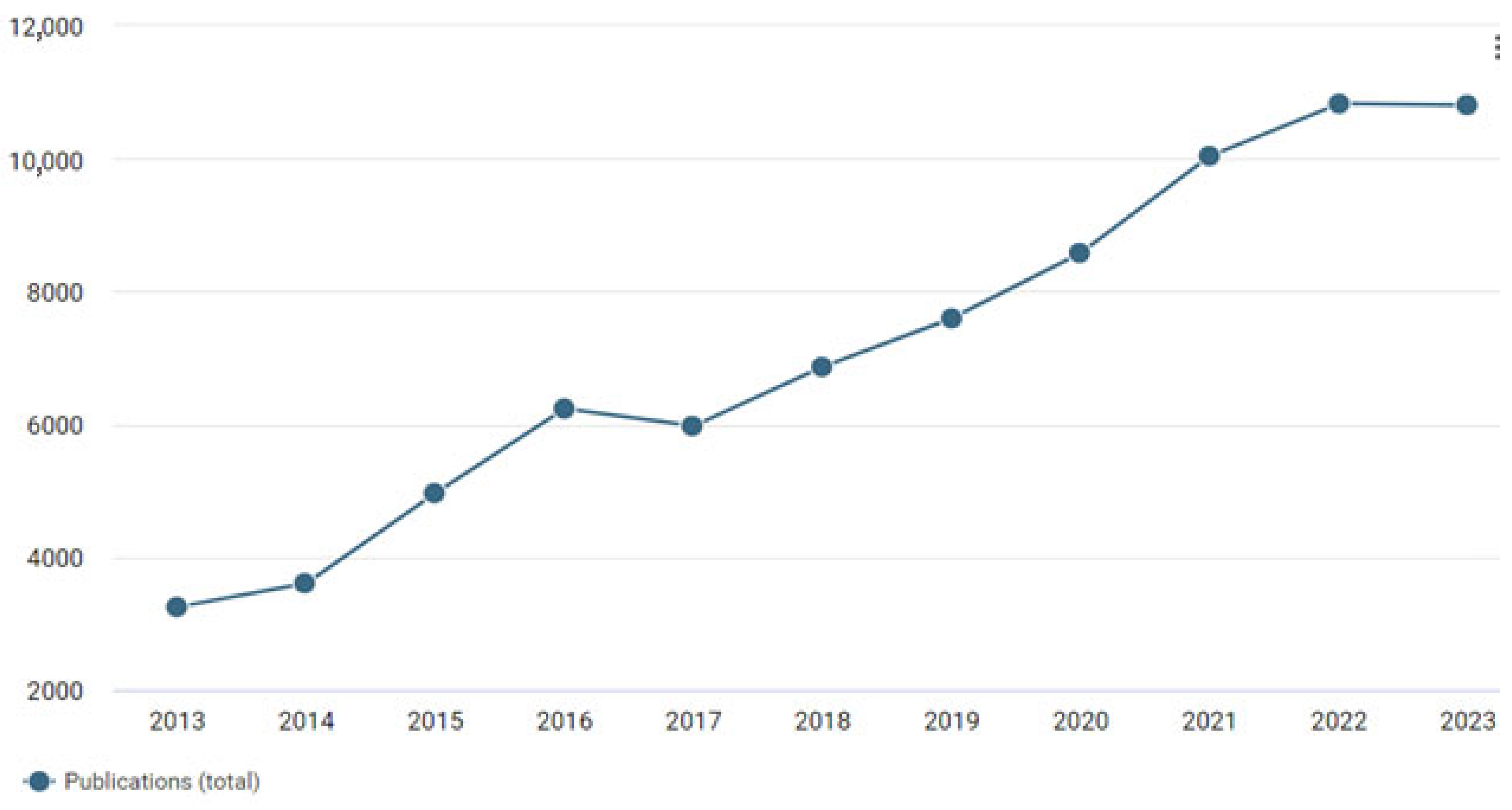

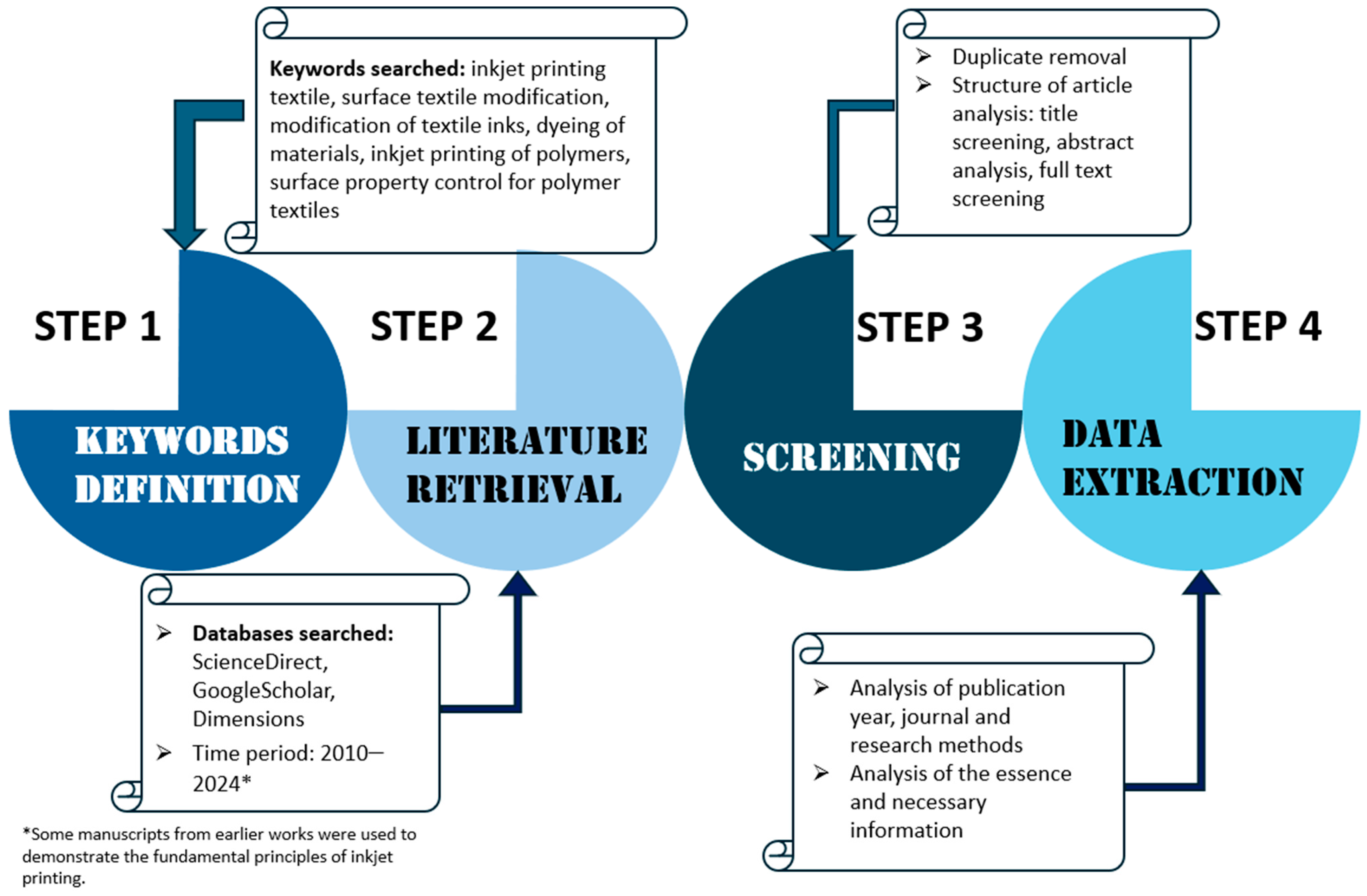

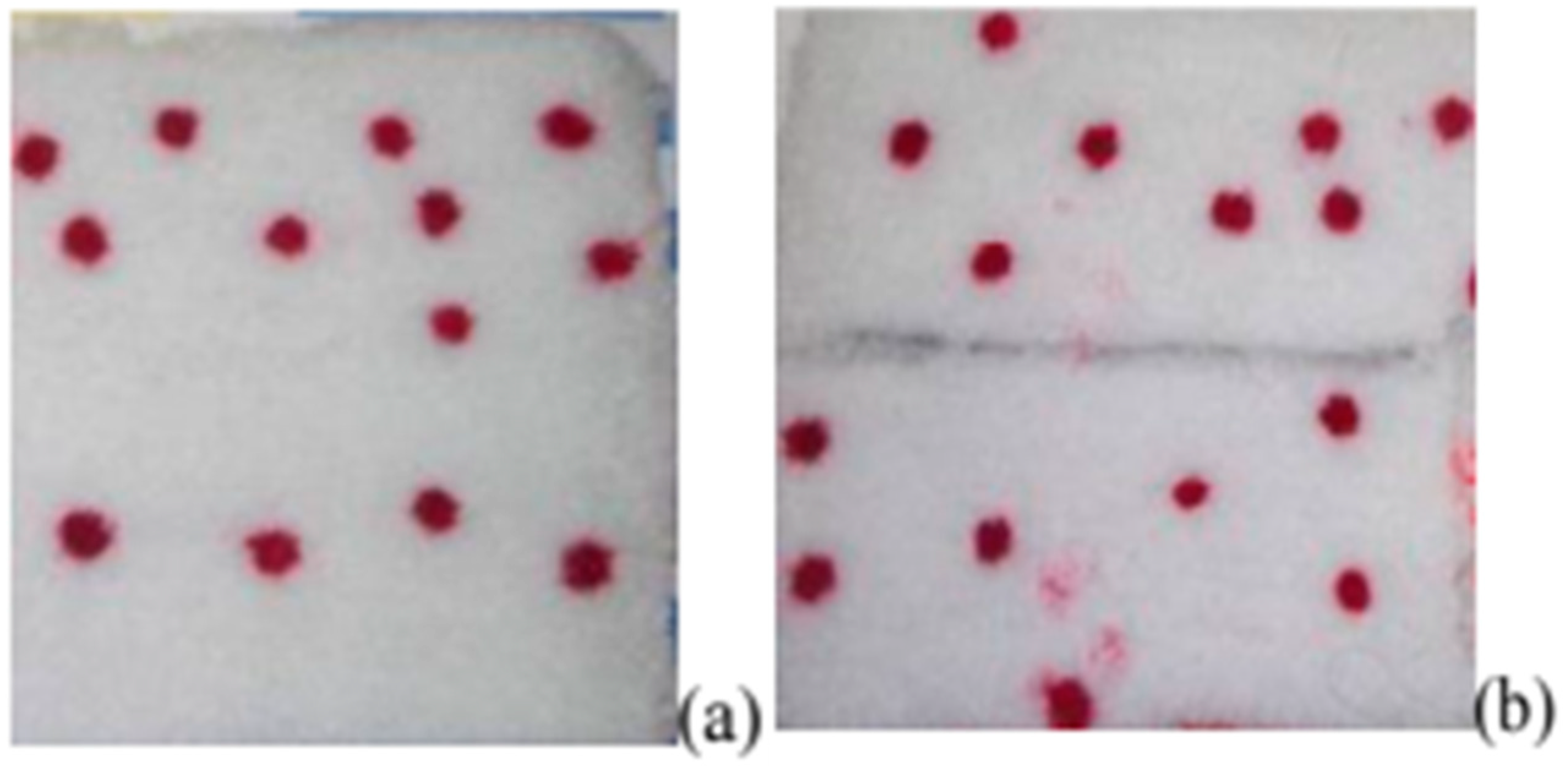
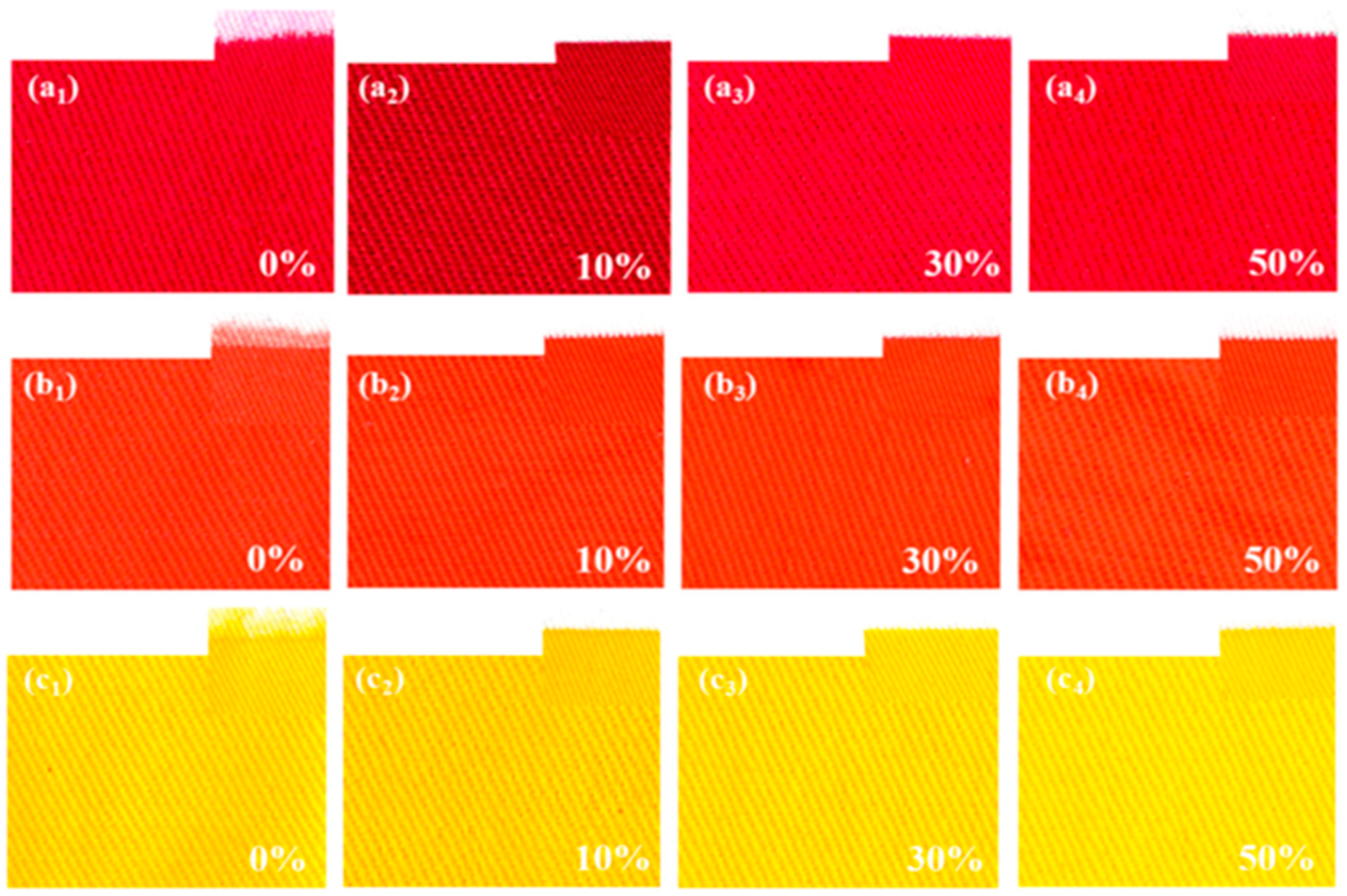





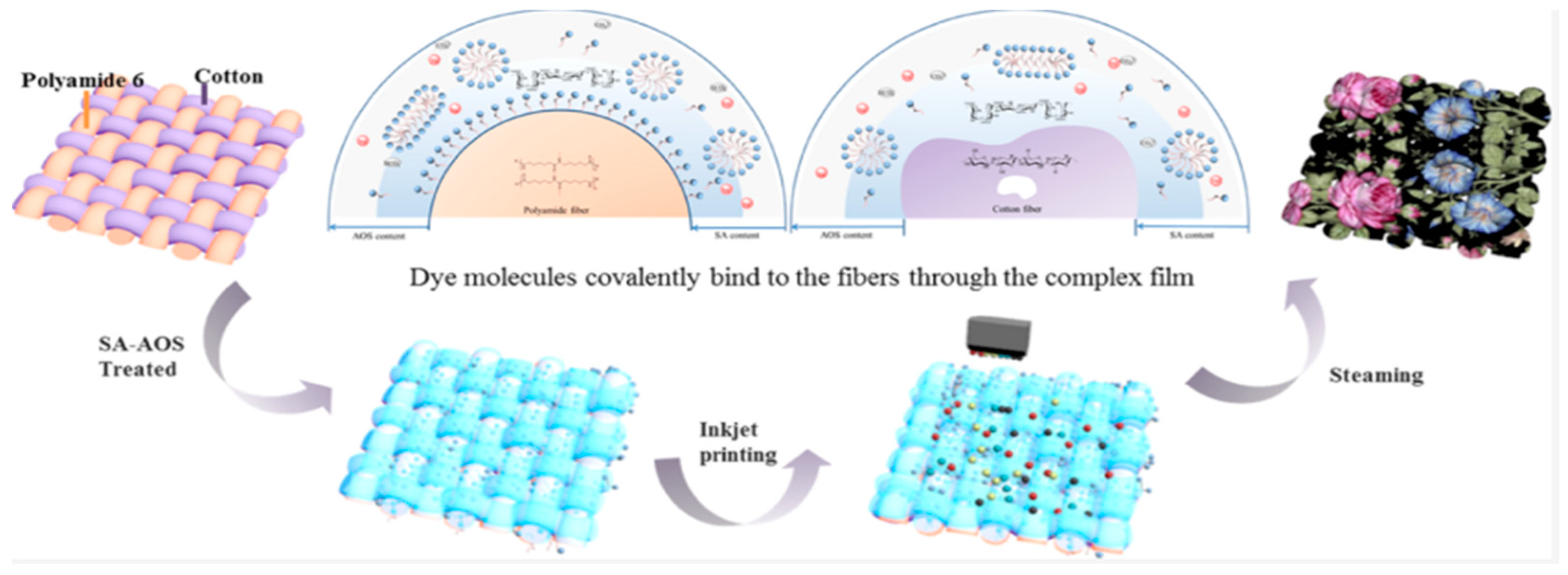
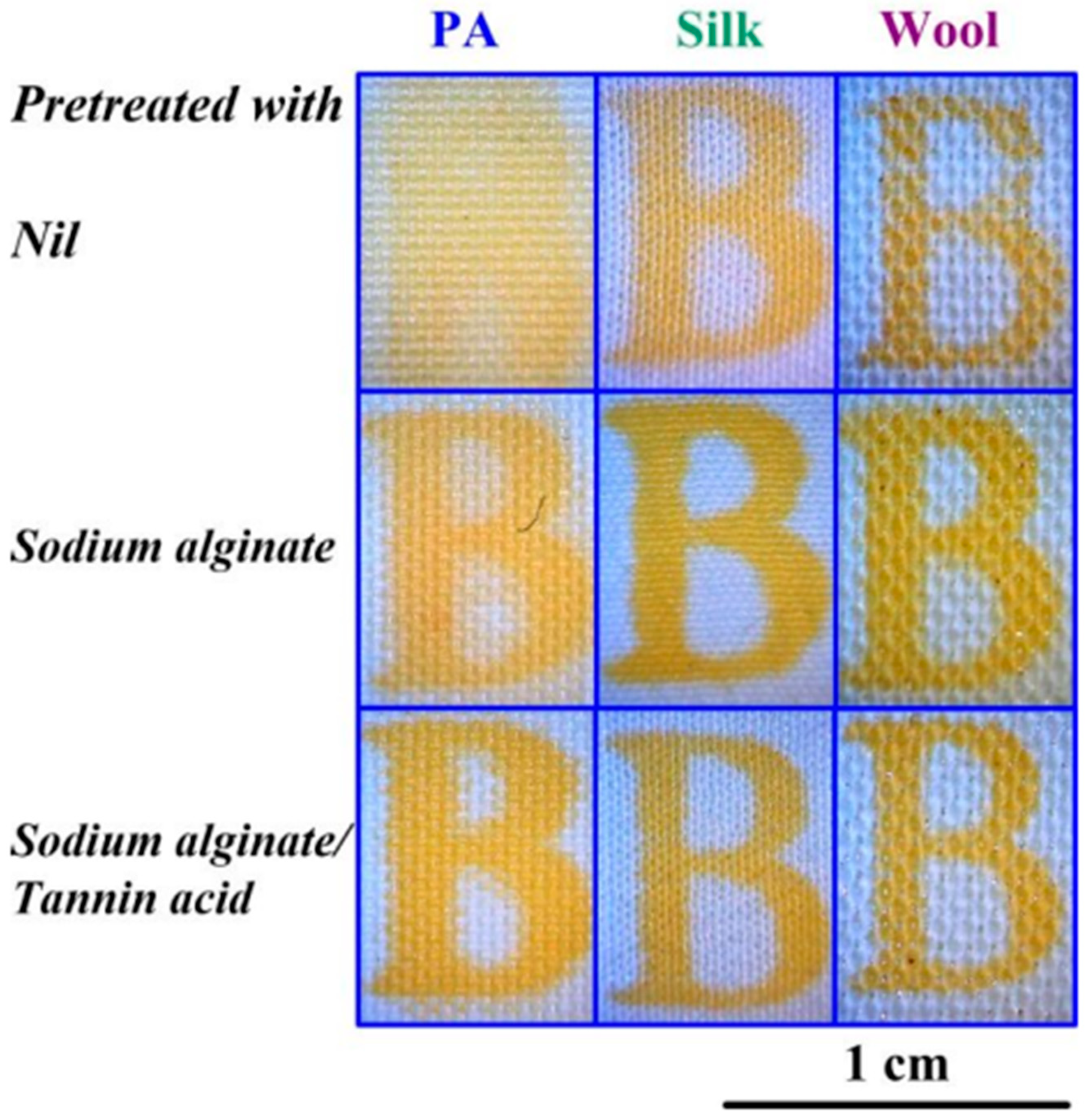
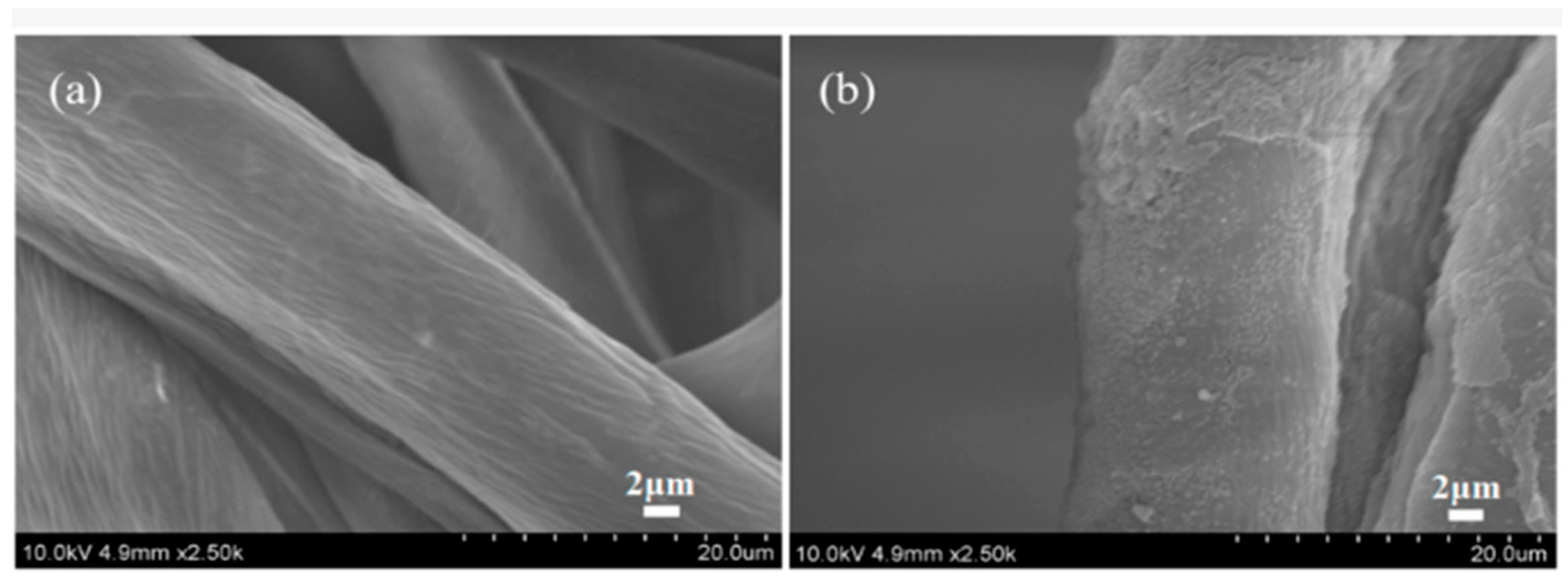

Disclaimer/Publisher’s Note: The statements, opinions and data contained in all publications are solely those of the individual author(s) and contributor(s) and not of MDPI and/or the editor(s). MDPI and/or the editor(s) disclaim responsibility for any injury to people or property resulting from any ideas, methods, instructions or products referred to in the content. |
© 2025 by the authors. Licensee MDPI, Basel, Switzerland. This article is an open access article distributed under the terms and conditions of the Creative Commons Attribution (CC BY) license (https://creativecommons.org/licenses/by/4.0/).
Share and Cite
Vodyashkin, A.A.; Makeev, M.O.; Mikhalev, P.A. Inkjet Printing Is a Promising Method of Dyeing Polymer Textile Materials. Polymers 2025, 17, 756. https://doi.org/10.3390/polym17060756
Vodyashkin AA, Makeev MO, Mikhalev PA. Inkjet Printing Is a Promising Method of Dyeing Polymer Textile Materials. Polymers. 2025; 17(6):756. https://doi.org/10.3390/polym17060756
Chicago/Turabian StyleVodyashkin, Andrey A., Mstislav O. Makeev, and Pavel A. Mikhalev. 2025. "Inkjet Printing Is a Promising Method of Dyeing Polymer Textile Materials" Polymers 17, no. 6: 756. https://doi.org/10.3390/polym17060756
APA StyleVodyashkin, A. A., Makeev, M. O., & Mikhalev, P. A. (2025). Inkjet Printing Is a Promising Method of Dyeing Polymer Textile Materials. Polymers, 17(6), 756. https://doi.org/10.3390/polym17060756








